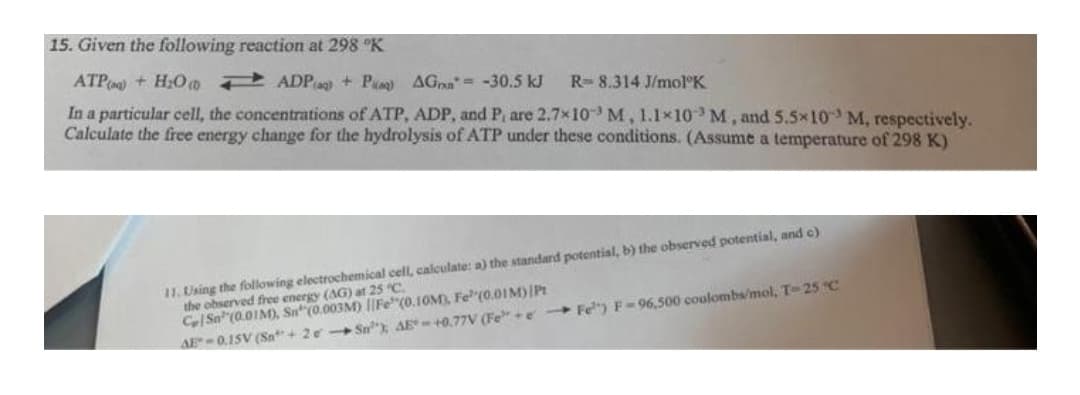15. Given the following reaction at 298 °K ATP) + H₂O ADP(aq) + P AG= -30.5 kJ R-8.314 J/mol K In a particular cell, the concentrations of ATP, ADP, and P, are 2.7×10 M, 1.1×10 M, and 5.5×10 M, respectively. Calculate the free energy change for the hydrolysis of ATP under these conditions. (Assume a temperature of 298 K)
15. Given the following reaction at 298 °K ATP) + H₂O ADP(aq) + P AG= -30.5 kJ R-8.314 J/mol K In a particular cell, the concentrations of ATP, ADP, and P, are 2.7×10 M, 1.1×10 M, and 5.5×10 M, respectively. Calculate the free energy change for the hydrolysis of ATP under these conditions. (Assume a temperature of 298 K)
General Chemistry - Standalone book (MindTap Course List)
11th Edition
ISBN:9781305580343
Author:Steven D. Gammon, Ebbing, Darrell Ebbing, Steven D., Darrell; Gammon, Darrell Ebbing; Steven D. Gammon, Darrell D.; Gammon, Ebbing; Steven D. Gammon; Darrell
Publisher:Steven D. Gammon, Ebbing, Darrell Ebbing, Steven D., Darrell; Gammon, Darrell Ebbing; Steven D. Gammon, Darrell D.; Gammon, Ebbing; Steven D. Gammon; Darrell
Chapter18: Thermodynamics And Equilibrium
Section: Chapter Questions
Problem 18.52QP: Consider the reaction of 1 mol H2(g) at 25C and 1 atm with 1 mol Br2(l) at the same temperature and...
Related questions
Question
Chemistry
helppp plz.

Transcribed Image Text:15. Given the following reaction at 298 °K
ATP) + H₂O
ADPaq) + Paq) AG= -30.5 kJ
R-8.314 J/mol K
In a particular cell, the concentrations of ATP, ADP, and P, are 2.7×10 M, 1.1×10 M, and 5.5×10 M, respectively.
Calculate the free energy change for the hydrolysis of ATP under these conditions. (Assume a temperature of 298 K)
11. Using the following electrochemical cell, calculate: a) the standard potential, b) the observed potential, and c)
the observed free energy (AG) at 25 °C.
Ce Sa (0.01M), Sn (0.003M) Fe(0.10M), Fe (0.01M) Pt
AE 0.15V (Sn+2e-Sn); AE+0.77V (Fee-Fe) F-96,500 coulombs/mol, T-25 °C
Expert Solution
This question has been solved!
Explore an expertly crafted, step-by-step solution for a thorough understanding of key concepts.
Step by step
Solved in 3 steps with 2 images

Knowledge Booster
Learn more about
Need a deep-dive on the concept behind this application? Look no further. Learn more about this topic, chemistry and related others by exploring similar questions and additional content below.Recommended textbooks for you

General Chemistry - Standalone book (MindTap Cour…
Chemistry
ISBN:
9781305580343
Author:
Steven D. Gammon, Ebbing, Darrell Ebbing, Steven D., Darrell; Gammon, Darrell Ebbing; Steven D. Gammon, Darrell D.; Gammon, Ebbing; Steven D. Gammon; Darrell
Publisher:
Cengage Learning

Chemistry: Principles and Reactions
Chemistry
ISBN:
9781305079373
Author:
William L. Masterton, Cecile N. Hurley
Publisher:
Cengage Learning

Chemistry by OpenStax (2015-05-04)
Chemistry
ISBN:
9781938168390
Author:
Klaus Theopold, Richard H Langley, Paul Flowers, William R. Robinson, Mark Blaser
Publisher:
OpenStax

General Chemistry - Standalone book (MindTap Cour…
Chemistry
ISBN:
9781305580343
Author:
Steven D. Gammon, Ebbing, Darrell Ebbing, Steven D., Darrell; Gammon, Darrell Ebbing; Steven D. Gammon, Darrell D.; Gammon, Ebbing; Steven D. Gammon; Darrell
Publisher:
Cengage Learning

Chemistry: Principles and Reactions
Chemistry
ISBN:
9781305079373
Author:
William L. Masterton, Cecile N. Hurley
Publisher:
Cengage Learning

Chemistry by OpenStax (2015-05-04)
Chemistry
ISBN:
9781938168390
Author:
Klaus Theopold, Richard H Langley, Paul Flowers, William R. Robinson, Mark Blaser
Publisher:
OpenStax

Chemistry
Chemistry
ISBN:
9781305957404
Author:
Steven S. Zumdahl, Susan A. Zumdahl, Donald J. DeCoste
Publisher:
Cengage Learning

Chemistry: An Atoms First Approach
Chemistry
ISBN:
9781305079243
Author:
Steven S. Zumdahl, Susan A. Zumdahl
Publisher:
Cengage Learning
